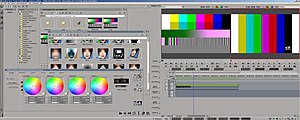Avid DS Nitris

Avid DS running on dual displays
|
|
| Developer(s) | Avid |
|---|---|
| Stable release |
11.1.1
|
| Operating system | Windows 7 |
| Type | Video editing software |
| License | Proprietary |
Avid DS (which was called Avid DS Nitris until early 2008) is a high-end offline and finishing system comprising a non-linear editing system and visual effects software. It was developed by Softimage in Montreal. Softimage was owned by Microsoft at the time of the launch of DS v1.0 and the company was acquired by Avid Technology Inc shortly thereafter.
DS was discontinued on September 30, 2013 with support ending on September 30, 2014.
DS was called ‘Digital Studio’ in development. It was envisioned to be a complete platform for video/audio work. The first previews of the system were on the SGI platform, but this version was never released. The system was rewritten on Windows NT with different video hardware platforms (Matrox DigiSuite or Play Trinity running on a NetPower system) before the final system was released on Intergraph/StudioZ hardware in January 1998.
After its acquisition by Avid, DS was always positioned as a high end video finishing tool. However, many users found it to be uniquely soup-to-nuts in its capabilities. From version 1.0 of the product, it competed with products like Autodesk Smoke, Quantel and Avid Symphony. The toolset in DS offered video timeline editing, an object-oriented vector-based paint tool, 2D layer compositing, sample based audio and starting with version 3.01 of the product, a 3D environment. Originally, a subset of the Softimage|XSI 3D software was planned to become part of the DS toolset, both were built on the same software foundation, but over time the code bases divided between the applications and the integration never happened.
While the first version of the DS still lacked a few key features (no 3D, poor keying, no real-time effects), it had some significant features compared to the competing products at the time. It offered a large number of built in effects. Avid OMF import was available, positioning Softimage DS as a strong finishing tool for then typical off-line Avid systems. Lastly the integration of the toolset of Softimage DS was beyond what other product offered. A Softimage DS user could quickly go from editing, to paint, to compositing with a few mouse clicks all inside the same interface. Some of the lacking features where quickly resolved, within months of version 1.0 a new chroma keyer was released.
Early versions of the software (up thru 4.0) added additional key features. Development continued with one of the first uncompressed HD editing systems (version 4.01) and an attempt to make the system more friendly to Media Composer editors in version 6. In later versions (v7.5 on beyond) DS was criticized for slow development of compositing tools, mainly lack of a new 3D environment and better tracking tools. Many DS users felt that Avid had not been giving DS the attention that it deserved.
...
Wikipedia
